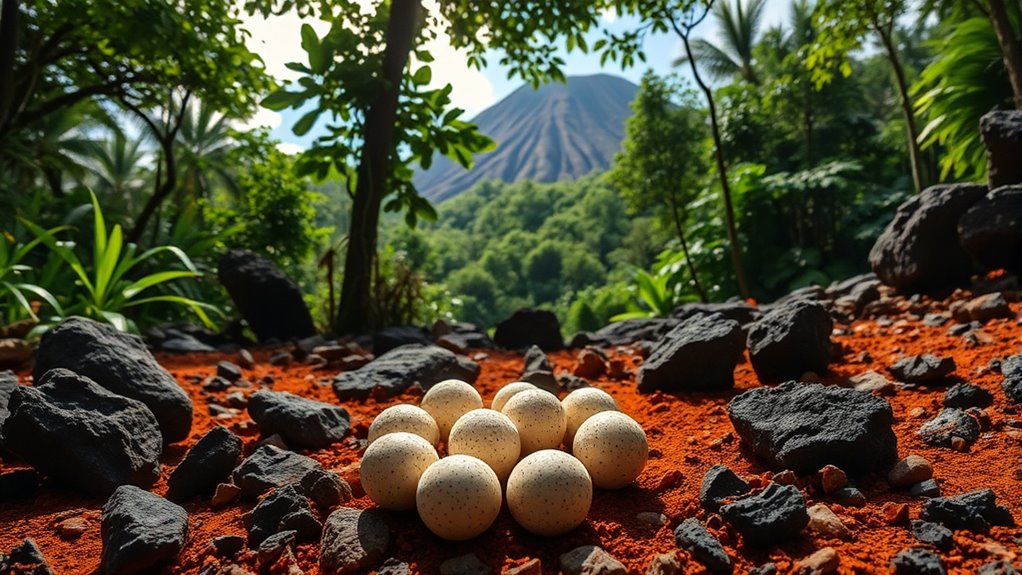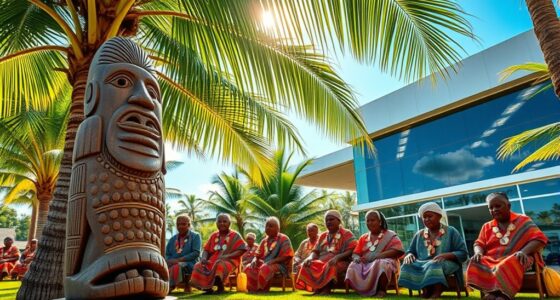In Papua New Guinea’s volcanic areas, megapodes have surprisingly turned geothermal heat into a natural incubator for their eggs. Instead of sitting on their nests, they gather eggs in large mounds and rely on nearby volcanic activity to keep them warm. This clever adaptation reduces energy use and guarantees higher hatch rates in harsh environments. If you want to understand how this fascinating strategy evolved, stay with us to uncover more about these remarkable birds.
Key Takeaways
- Megapodes in PNG utilize geothermal heat from volcanic activity to incubate their eggs, bypassing traditional nesting behaviors.
- They construct large compost mounds or nest sites that harness natural heat sources for consistent incubation temperatures.
- Their unique incubation strategy demonstrates adaptation by exploiting volcanic energy, reducing energy expenditure and increasing hatch success.
- This behavior highlights evolutionary ingenuity in using environmental resources, challenging typical bird reproductive methods.
- The volcano-incubation phenomenon exemplifies how species adapt to and capitalize on their specific, often hazardous, environments.

The mystery of megapode eggs has fascinated scientists and nature enthusiasts alike for years. These extraordinary birds, native to regions like Papua New Guinea, have developed a unique way to incubate their eggs that defies the norms of bird behavior. Unlike most birds that rely on body heat or simple nest structures, megapodes use environmental heat sources, such as volcanic activity, to incubate their eggs. This adaptation not only highlights their remarkable survival strategies but also sparks curiosity about how their reproductive behaviors evolved.
When you observe a megapode, you notice that their egg incubation process is unlike that of many other bird species. Instead of building elaborate nests or incubating eggs with their body heat, these birds gather their eggs in large mounds of compost, soil, or other organic material. In regions with volcanic activity, like parts of PNG, they often utilize the geothermal heat to maintain the necessary temperature for embryonic development. This behavior showcases their ability to adapt to their environment and exploit available resources to ensure their offspring’s survival.
Understanding bird behavior in this context reveals an intriguing aspect of evolution. Megapodes have developed the instinct to select and manage their nesting sites carefully, often monitoring the temperature of their mounds over time. This active management of their nests demonstrates a level of behavioral complexity that’s rare among birds. You might think of it as a form of environmental manipulation, where they use natural heat sources to optimize incubation conditions. The heat from volcanic activity provides a consistent and reliable temperature, giving their eggs a better chance of hatching successfully, even in unpredictable climates. Additionally, their reliance on geothermal energy exemplifies how they have evolved to utilize natural environmental factors for reproductive success.
As you explore further into this phenomenon, you realize that the combination of egg incubation techniques and bird behavior in megapodes indicates a sophisticated survival strategy. They don’t rely solely on instinctual nesting; instead, they adapt their behavior to harness natural geothermal energy, which reduces the energy expenditure associated with incubation. This approach also means that their reproductive success heavily depends on the availability of suitable volcanic sites, making their behavior highly localized and specialized.
In essence, the way megapodes manage their eggs exemplifies a fascinating intersection of nature’s ingenuity and behavioral adaptation. Their reliance on volcanic heat to incubate eggs not only underscores a unique aspect of bird behavior but also challenges your understanding of how species evolve to survive in diverse environments. It’s a perfect example of how animals can develop extraordinary strategies based on their surroundings, turning natural hazards into reproductive advantages.
Frequently Asked Questions
How Do Megapodes Regulate Egg Temperature Without Parental Care?
You might wonder how megapodes regulate egg temperature without parental care. They use environmental adaptation by building mounds or burrows that harness natural heat sources like decomposing vegetation or volcanic heat. These structures insulate the eggs, maintaining a stable temperature for incubation. This clever method allows them to control temperature regulation passively, ensuring successful development even without direct parental involvement.
Are Megapode Eggs Edible for Humans?
You might wonder if megapode eggs are edible for humans. Yes, they are; locals often harvest these eggs for culinary uses, appreciating their rich flavor. During egg harvesting, you can collect them from nests, but guarantee sustainable practices to avoid harming populations. In some regions, these eggs are considered a delicacy, enjoyed boiled or cooked in various dishes. Always check local regulations and traditions before consuming megapode eggs.
How Long Does Incubation Last in Volcanic Environments?
Imagine a fiery cradle nurturing life’s delicate promise. In volcanic incubation, the egg temperature remains remarkably stable, guiding development. You’d find that this unique process lasts about 40 to 50 days, depending on the volcano’s heat and environmental factors. This extraordinary natural method showcases nature’s ingenuity, where the intense warmth of the Earth itself becomes an essential incubator, shaping the future in a fiery embrace that’s both fierce and nurturing.
Do Megapodes’ Volcanic Nests Ever Erupt or Get Damaged?
You might wonder if megapodes’ volcanic nests ever erupt or get damaged. While volcanic activity can pose risks, these birds build their nests carefully in stable volcanic soils, which typically resist eruptions. The nest stability is usually maintained because the eggs are buried deep enough to avoid direct damage from minor eruptions or ground shifts. However, significant volcanic activity could threaten their nests, making these birds adapt to such unpredictable environments.
What Predators Threaten Megapode Eggs in PNG?
You might wonder what threats megapode eggs face in PNG. Avian predators, like large birds or monitor lizards, pose a significant risk by raiding nests. Environmental threats, such as habitat loss and climate change, also threaten their survival. These factors combined make it challenging for megapodes to successfully incubate and hatch their eggs, emphasizing the importance of conserving their natural habitats and protecting nests from predators.
Conclusion
As you marvel at the megapode’s volcanic incubation, remember nature’s surprising ways. While humans rely on technology and tradition, these birds harness fiery heat, turning volcanoes into nurseries. It’s a striking contrast—ancient fire shaping new life, a fiery forge instead of a laboratory. In this wild dance between nature and instinct, you see that sometimes, the oldest methods still create the most extraordinary results. It’s a reminder: nature’s mysteries often outshine our greatest innovations.









